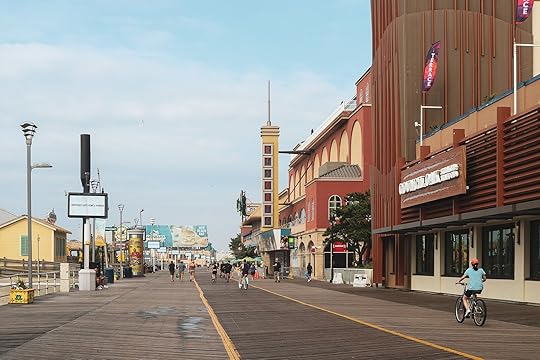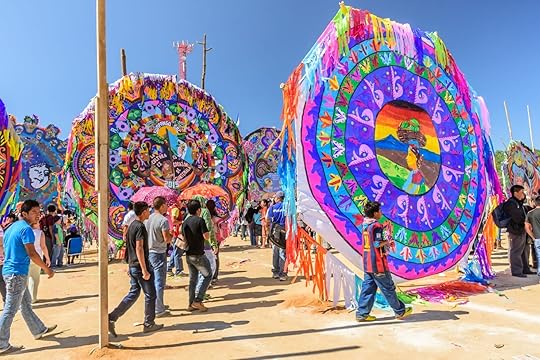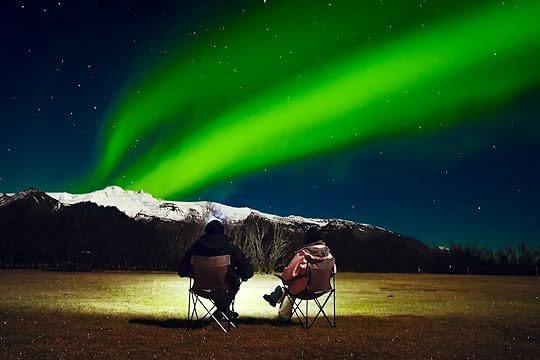Matador Network's Blog, page 12
September 8, 2025
From Casinos to Culture: How Atlantic City Is Reshaping Its Tourism

As the sun rises over the Atlantic City skyline on a summer weekend, the boardwalk comes alive with souvenir shops opening their doors, bicyclists and joggers zipping by.
The Atlantic City Boardwalk, built in 1870, remains the city’s defining landmark. It was originally built to prevent visitors from bringing sand into the hotel resorts and railroad cars, but it quickly grew from one mile to five miles as more visitors flocked to the city. Steel Pier, first opened in 1898, cemented Atlantic City’s reputation as a show town. For decades, the wooden pier was one of the most popular public venues in the US, thanks to its multitude of entertainment options, including the famous high-diving horses, before it was destroyed by fire in 1982. The current concrete pier was built in 1993.

Photo: Daria Bachmann
Anchored by the boardwalk, the pier, and a row of glittering casinos along a wide sandy beach, Atlantic City was home to the first Miss America Pageant before transforming into an East Coast entertainment hub in the late 20th century. But after the city came out of the recent economic downturn, its revitalization effort is now focused on showcasing a different side — one full of culture, history, and local flavor.
“We are showcasing what’s beyond the casinos and really going into our diverse culture and our neighborhoods,” said Jessica Kasunich, the director of communications at Visit Atlantic City, the entity tasked with marketing the destination.
While new developments such as Ocean Casino Resort and the Hard Rock Hotel helped to breathe new life into the city thanks to shopping, dining, and entertainment options, small establishments such as the Tennessee Avenue Beer Hall — run by a local entrepreneur — reopened their doors after a series of renovations.
Seeing a different side of Atlantic City
Photo: Daria Bachmann
Nicknamed “America’s Playground,” a reputation long tied to casinos and beach culture, today’s Atlantic City is cultivating a broader identity. Food, art, history, and neighborhood hangouts are reshaping how visitors experience the city.
Dining plays a big part in that shift, with dozens of restaurants from classic American diners (such as Gilchrist) to Asian, Italian, and other global fare. One standout is the Afghan-French eatery Setaara, a unique spot that blends the aesthetic of a French bistro with authentic handmade wooden doors and velvet furniture.
Culture plays an equally important role, and the Atlantic City Arts Foundation supports the city’s nascent art scene. Thanks to its ongoing collaborations with artists, 100 murals now grace the city’s buildings. Although casinos and resorts remain the dominant force in the town of 39,000 people, new activities that cater to more curious travelers are plentiful.
A few steps from Atlantic City’s main drag, a different world awaits. Whether you want to try craft beer at under-the-radar dive bars, check out colorful street art, or grab a bite at Atlantic City Subs, a long-time staple of the city’s culinary scene, you won’t run out of things to do.
One of the most overlooked activities in the area is Atlantic City Cruises, which offers a combination of coastal views and local history. After departing from 800 North New Hampshire Avenue, the boat makes its way along the waterfront, while a captain provides curious insights into the city’s past, from the early 20th century and the economic fallout of the last decade to the present day.

Photo: Daria Bachmann
By lunch time, beachfront restaurants like the Queen Bean Bistro in Ventnor City get packed with hungry visitors. As the afternoon kicks off, many families head to Island Waterpark, the world’s largest beachfront indoor water park inside the Showboat Resort that opened in 2023.
Later in the day, head to the Atlantic City Historical Museum for some local history. The museum offers a deep dive into how the city was shaped over the last century and features exhibits and memorabilia from its key events. Then make time for a popular attraction: the Absecon Lighthouse. It’s New Jersey’s tallest lighthouse and the third tallest lighthouse, standing 171 feet tall and requiring visitors to climb 228 steps to the top. One of the top historic landmarks in the city, the Absecon Lighthouse is a perfect spot to take in the coastal views.
In the evening, to combine a night out with some education, check out Little After Distillery for tastings with detailed explanations of the distilling process, or head to The Hook, a live show with heart-pounding acrobatics that pays homage to the city’s golden age.
Monopoly, murals, and a destination redefined
Photo: Daria Bachmann
This year marks the 90th anniversary of Monopoly, a popular board game that was inspired by the 1930 map of Atlantic City. Over time, the game gave Atlantic City a kind of pop culture immortality, so don’t be surprised if some of its streets’ names sound familiar.
The city has since tapped into that fame, using Monopoly in marketing, public art, and events. Case in point: The Top Hat, a Monopoly-themed boutique hotel, is set to open its doors in the city this year, with accommodations and mixed-use space.
The city’s Orange Loop — a three-block stretch not far from the boardwalk that’s home to dozens of incredible murals created by visiting artists in collaboration with the Atlantic City Arts Foundation— borrows its name from the board game, complete with New York Avenue, St. James Place, and Tennessee Avenue. The mural featuring the Monopoly board on Pacific Avenue commemorates the connection between the city and the famous game.
The Atlantic City Arts Foundation, whose goal is to transform the city through public art, works to encourage visitors to do things outside of casinos.
The foundation’s mural initiative began in 2017 as part of 48 Blocks Atlantic City, a June festival highlighting local art, culture, and communities. The program has since installed 100 murals and formed partnerships with local businesses and visiting artists.
“That’s my emphasis to make sure that when we are doing a mural, it’s adding something unique. As much as there’s opportunities, there’s a finite number of walls, so we want all of them to be the highest quality and to reflect a strand of our community history and journey,” said Michael Atkins, the executive director of the Atlantic City Arts Foundation.

Photo: Daria Bachmann
The city’s 100th mural, “Always Dreaming, Always Growing” by Swiss-American artist Mona Caron, was completed in 2024 along the side of the restaurant Cardinal. The artwork embodies the essence of Atlantic City, narrating themes of resilience and perseverance, and giving visitors a reason to venture off the beaten path and explore the areas not usually promoted in marketing brochures.
“The healthy city has an active arts community,” Atkins said, as he led a tour through the Orange Loop district.
Although the city still has a fair share of empty parking lots, the colorful new art invites visitors on a self-guided tour to explore the tales of local history. Also worth seeing for the arts-inclined is the Noyes Arts Garage of Stockton University, located about a mile from the Orange Loop. The pillar of Atlantic City’s Art District, this space is home to local artists and pop‑up galleries as it offers support and resources for emerging artists.
If you’re willing to venture past the neon lights of the casinos, you’ll discover a different side of Atlantic City — one with unique history, diverse food options served with love by the city’s hard-working culinary entrepreneurs, and an emerging art scene that aims to support local diversification efforts. 
Halloween traditions around world

Halloween traditions have roots in a Celtic pagan festival called Samhain, traditionally held between the fall equinox and winter solstice to mark the harvest. It was seen as a time of transition when spirits could rise and roam the earth. To ward them off, Celts lit bonfires and wore fearsome costumes.
In the eighth century, after Pope Gregory III devoted November 1 to honoring saints, Samhain traditions became All Saints’ Day festivities, and the night before was known as All Hallows’ Eve, eventually Halloween. Like St. Patrick’s Day, the holiday took on a new life after Irish immigrants brought it to the US in the 19th century. Today, America’s over-the-top celebration of costumes, candy, and spooks has helped redefine Halloween worldwide.
Some places, like the Celtic nations and the Philippines, have folded old customs into modern Halloween. Others, especially in Latin America, observe the season with different rituals of remembrance. Here’s how Halloween looks around the world.
Ireland
Photo: mark gusev/Shutterstock
Today, Halloween in Ireland looks a lot like it does in the US, albeit on a smaller scale. Pranks like egging are still common, as are games like snap apple in County Kerry, where the fruit dangles from strings instead of bobbing in water. Some present-day customs still echo Samhain. Bonfires are fixtures across the country, and fireworks close out the Banks of the Foyle Carnival in Derry, now considered the largest Halloween festival in Europe, drawing more than 100,000 visitors each year.
In recent years, Ireland has also reclaimed Halloween with the Púca Festival, which has grown into a signature celebration. Staged in County Meath, it mixes concerts, light shows, storytelling, and food markets with a Samhain procession on the Hill of Ward, tying the modern revelry back to its Celtic roots. In Galway, the Macnas Parade floods the streets with towering puppets and live music, while Dublin marks the season with the Bram Stoker Festival, a gothic mix of theatre, installations, and late-night parties.
Scotland
Photo: Andris Barbans/Shutterstock
Scottish and Irish Halloween traditions share many similarities, but Scotland adds its own unique twists. Children carve neep lanterns — turnips that were traditionally used before pumpkins became popular — and play apple dooking, the Scottish version of bobbing for apples. Another favorite party game involves trying to eat treacle-covered scones hanging from strings, all without using hands.
The hallmark tradition, though, is guising. Children dress in disguise and perform a “party piece” — a song, a rhyme, a joke — before receiving fruit, nuts, or coins. Unlike today’s candy-for-costume swap, guising demands effort and many children practice weeks in advance. It’s this practice that crossed the Atlantic with Scottish and Irish immigrants and evolved into what Americans now know as trick-or-treating.
Some of Scotland’s unique Halloween traditions also revolve around romance, of all things. Nut cracking is a tradition for recently engaged couples, who are meant to throw a nut into a bonfire to see how their marriage will fare: If the nut cracks open quietly, it’ll be a smooth marriage, while if it hisses and pops, it’ll be a rocky union. For singles, there’s also kale pulling, which entails uprooting kale stalks to reveal the height and general figure of your future partner.
Japan
Photo: Sean Pavone/Shutterstock
Halloween in Japan is neither about the ghoulish and gruesome nor the promise of candy. It’s not even marketed toward kids. As the Japanese celebrate their dead during the Obon Festival in July or August, October 31 is merely an excuse for adults to cosplay and flood the streets.
Halloween was slow to take hold in Japan, growing in popularity ever since Disneyland Tokyo organized its first spooky event in 1997. Bars and clubs later caught on, hosting theme nights, and small parades started forming. In recent years, the holiday has exploded in cities like Tokyo, Osaka, and Kanagawa. Shibuya Crossing became the country’s most famous Halloween gathering spot, but after crowd trouble in the late 2010s, the city imposed alcohol bans and tighter controls. Even so, thousands still converge in Shibuya each year, while Harajuku retains its reputation as an early hub for Japan’s Halloween culture.
Amusement parks remain the biggest draw. Tokyo Disneyland and DisneySea stage elaborate parades and character events throughout the season, and Universal Studios Japan in Osaka goes all-in with horror attractions, zombie street performances, and seasonal rides. These theme parks set the tone for Halloween in Japan, turning it into one of the country’s largest seasonal celebrations.
Austria
Photo: Elena Schweitzer/Shutterstock
Austrians celebrate Seelenwoche, or All Souls’ Week, between October 30 and November 8. A relatively sober holiday, it largely revolves around church services. There is one notable Halloween tradition in Austria, however: it’s customary to leave bread, water, and lanterns out on the night of October 31, much like kids do for Santa Claus on Christmas Eve. Halloween night is said to be rife with cosmic energy, and the offerings are intended for wandering souls. Like in the US, Halloween is also a time for pumpkins in Austria, though the focus is on growing, showing, and eating the gourds rather than carving them.
Traveling this fall? Check out Matador’s guides to the leaf-peeping season: The 14 Best Places for Leaf Peeping in United States in 2025 The Cutest A-Frame Airbnbs for a Perfect Holiday Season Escape in the Northeast 16 Haunted Airbnbs You Can Actually Spend the Night In This Halloween 16 Scenic Train Rides to See the Best Fall Foliage in the US New England’s Most Breathtaking Fall Foliage Road Trips The Most Wish-Listed US Cabins on Airbnb Italy
Photo: Massimo Santi/Shutterstock
Halloween in Italy blends Celtic traditions, which ancient Italians witnessed firsthand as the Roman Empire conquered the Celtic nations, and American Halloween. Candy, costumes, and jack-o-lanterns are increasingly popular, as are Halloween parties in bars and restaurants. Trick-or-treating, or dolcetto o scherzetto, is also catching on, though children go from store to store collecting small treats rather than knocking on front doors.
Outdoing haunted houses elsewhere, Italians organize tours of ancient sites like catacombs and castles on Halloween night, as well as flock to amusement parks for terror-themed events. A handful of towns take Halloween particularly seriously, getting decked out in scary decorations and hosting everything from fire spinners and tarot card readers to Miss Strega (Miss Witch) pageants, and jump-scare-filled walks through a Passage of Terror.
The most popular places to celebrate are Corinaldo in the Marche region for the Festa della Streghe, which translates either to Witches’ Feast or Witches Festival; Triora, Liguria, the city that hosted Italy’s last witch trials during the Renaissance; and Borgo a Mozzano, Tuscany, with celebrations largely centered on the Ponte della Maddalena, also known as the Ponte del Diavolo or Devil’s Bridge.
Philippines
Photo: Rainier Ampongan/Shutterstock
October 31 kicks off the Philippines’ All Saints’ Day festivities, which are more family-oriented than America’s raucous Halloween parties. The entire holiday is meant to honor deceased relatives, with families lighting lanterns and visiting the cemeteries where their loved ones are buried. Many leave food offerings, and some even camp out. That said, you’ll also see parades, parties, and other familiar Halloween traditions in Manila and larger cities.
Smaller towns often host trick-or-treating events for kids, with stores leaving out small treats for them to collect. Slowly, trick-or-treating is replacing the practice of pangangaluluwa where groups of children go around to different houses singing carols about souls for alms, generally money or food, a tradition that’s still practiced in the rural provinces. Most children dress in scary costumes. Though many bars host Halloween parties in the Philippines, it’s a family-centric holiday meant to honor loved ones rather than celebrate ghosts.
Isle of Man
Photo: Henryk Sadura/Shutterstock
A semi-autonomous British Isle that marches to the beat of its own drum, the Isle of Man hosts its own festival on Halloween night: Hop-tu-Naa. Like Samhain, the holiday began as a way to usher in the harvest and the Celtic New Year. Yet much like in Ireland today, October 31 has been Americanized on the Isle of Man. Still, a Manx Halloween will almost certainly involve activities like carving lanterns out of turnips and going around to different houses while singing old folk songs. Small towns put on festivals across the island that are a little bit Hop-tu-Naa, a little bit Halloween, and a lot of fun.
Mexico
Photo: Kobby Dagan/Shutterstock
Of all the fall celebrations tied to spirits and the afterlife, Mexico’s Día de los Muertos is by far the best known. Taking place on November 1 and 2, it combines Indigenous Aztec rituals with Catholic All Saints’ and All Souls’ Days. Families build ofrendas, or altars, layering marigolds, sugar skulls, candles, and photos alongside the favorite dishes and drinks of the departed. Public celebrations are elaborate, from Mexico City’s processions and parades to Oaxaca’s vigils filled with music and dance. At the same time, the holiday is deeply personal, centered on homes and cemeteries where families gather to remember and celebrate those they’ve lost.
Guatemala
Photo: Lucy.Brown/Shutterstock
On November 1, the towns of Sumpango and Santiago Sacatepéquez turn their cemeteries into festival grounds. Families gather among the graves to fly massive handmade kites — some stretching nearly 60 feet across — that are believed to carry messages to the spirit world. The day is tied to All Saints’ traditions, but the practice is uniquely Guatemalan, rooted in both Indigenous and Catholic beliefs. The kites are built from paper and bamboo and decorated with bold geometric designs, portraits, or messages that change each year. Flying them is a communal effort, with families picnicking by the graves and entire neighborhoods turning out to watch. 
September 7, 2025
Haunted hotels around the world

When some people vacation, they like to relax. Tropical beaches, sunny weather, cocktails by the pool — you know the drill. For others, though, something off the normal circuit is in order, something…freaky. If you’re looking for that kind of holiday experience, these ghostly getaways give you the opportunity to experience a little bit of the paranormal first hand — or spook yourself out trying. There are locations all across the United States where you can spend the night searching for spirits, in addition to haunted places to stay as far and wide as Italy and Wales. If you’re looking for the ultimate Halloween getaway, these are the most haunted hotels to sleep in — with one eye open.
We hope you love the spooky stays we recommend! Just so you know, Matador may collect a small commission from the links on this page if you decide to book a stay.
Jump to haunted hotels in EuropeThe Queen Mary, California
Photo: Queen Mary
Docked permanently in Long Beach, the Queen Mary is both a hotel and one of the most famous haunted ships in the world. Legends surround the vessel’s darker corners: the engine room’s “Door 13,” where a crewman was crushed during a drill, and the drained first-class swimming pool, where visitors still report splashes and footsteps in the empty chamber. The ship offers two main ghost experiences. Haunted Encounters is a one-hour daytime tour through the areas most often tied to strange sightings. The Paranormal Ship Walk takes guests into restricted sections at night for a hands-on investigation with ghost-hunting tools. The bravest can book an overnight stay in Stateroom B340, long considered the vessel’s most paranormally charged cabin. Each fall, the ship goes all in with Dark Harbor, a Halloween festival that fills the decks with haunted mazes and roaming performers.
Where: The Queen Mary, 1126 Queens Highway, Long Beach, California
Book NowThe Farnsworth House Inn, Pennsylvania
Photo: Farnsworth House Inn
During the Battle of Gettysburg, the Farnsworth House sheltered Confederate sharpshooters, and its brick walls still bear more than a hundred bullet scars from the fighting. Local legend says the spirits of those soldiers never checked out — guests report the sound of boots pacing overhead, snatches of fife-and-drum music, and even visits from ghostly figures in the bedrooms. Today, the inn builds on that haunted reputation with nightly candlelit tours and “Mourning Theatre” performances in the cellar, where guides in period costume tell stories of Gettysburg’s darker side. For those who want to go further, ghost hunts with EMF meters and night-vision cameras take curious visitors into the attic and other active spaces long after the living have gone to bed.
Where: Farnsworth House Inn, 401 Baltimore Street, Gettysburg, Pennsylvania
Book NowThe Stanley Hotel, Colorado
Photo: Glenn Taylor/Shutterstock
We, of course, can’t overlook The Stanley Hotel, the Estes Park, Colorado standby which gained fame as the inspiration for the Overlook Hotel in Stanley Kubrick’s The Shining, based on the Stephen King book of the same name. The Stanley family, who established the remote hotel to experience the healing winter air of the high Rockies, apparently never actually checked out of the place. It’s reported that they haunt the corridors, which provided ample inspiration for the creepy book and movie, as well as the nightly tours that draw ghost fanatics from around the globe. The hotel’s spirited reputation peaks each October with the annual Shining Ball, a costume party that draws horror fans from around the world. For anyone hoping to channel their inner Torrance, a night in the Stanley promises both luxury and unease in equal measure.
Where: The Stanley Hotel, 333 East Wonderview Avenue, Estes Park, Colorado
Book NowLizzie Borden Bed and Breakfast, Massachusetts
Photo: WanderRoamRove/Shutterstock
The name is a dead giveaway with this one. The Lizzie Borden Bed and Breakfast is based in the former home of its namesake, everyone’s favorite axe murderer. Located in Fall River, Massachusetts, the house was the scene of the brutal killings of various members of the Borden clan and must be one of the most famously haunted places to stay in the Northeast. You can stay in the very rooms where they met their endings or in Lizzie’s room itself. Tours of the house are run every day, or you can rent the whole house for an extra creepy family reunion.
Where: Lizzie Borden House, 230 Second Street, Fall River, Massachusetts
Book NowJerome Grand Hotel, Arizona
Photo: FiledIMAGE/Shutterstock
Looking out over the old copper mining town of Jerome, the Jerome Grand Hotel has a past as chilling as its clifftop views. Originally built in 1926 as a hospital, the building was converted into a hotel in the 1990s and quickly became famous for its paranormal activity. Guests have described lights flicking on and off, furniture shifting on its own, and the sound of children laughing in empty hallways. Among the eeriest reports is the ghost of Claude Harvey, a maintenance man who died in the elevator shaft in 1935; many say his footsteps can be heard near the lift. Today, visitors can book a stay, dine at the aptly named Asylum Restaurant, and see for themselves why the Jerome Grand is often called Arizona’s most haunted hotel.
Where: Jerome Grand Hotel, 200 Hill Street, Jerome, Arizona
Book NowThe Marshall House, Georgia
Photo: Darryl Brooks/Shutterstock
Savannah has no shortage of ghost stories, but The Marshall House is one of the city’s most famous haunts. Built in 1851, the building once served as a Civil War hospital and later housed patients during yellow fever outbreaks. Guests today say the past is still alive inside its walls, with faucets that turn on by themselves, flickering lights, and ghostly children running through the halls. Stories from visitors often mention shadowy soldiers missing limbs, said to be the spirits of those who never left the hospital wards. Despite its eerie reputation, the hotel embraces its history — wine receptions in the library are a nightly tradition, and its central location makes it a favorite stop on Savannah’s many ghost tours.
Where: The Marshall House, 123 East Broughton Street, Savannah, Georgia
Book Now1886 Crescent Hotel and Spa, Arkansas
Photo: Patrick Horton/Shutterstock
The Crescent Hotel first opened in 1886 as a grand resort in the heart of the Ozarks. Its story took a darker turn in the 1930s, when a con artist posing as a doctor transformed the property into a hospital and lured desperate patients with promises of miracle cancer cures. Many of those patients died here, and their stories have become part of the hotel’s haunted reputation. Guests speak of ghostly figures appearing in mirrors, voices drifting from empty rooms, and a spectral cat that slips silently through the lobby. Embracing its eerie past, the hotel now offers nightly ghost tours, while Room 218 has earned a reputation as one of the most paranormally active spots in the South.
Where: 1886 Crescent Hotel and Spa, 75 Prospect Avenue, Eureka Springs, Arkansas
Book NowMagnolia Hotel, Texas Photo: Airbnb
Photo: Airbnb Photo: Airbnb
Photo: AirbnbIn the heart of Seguin’s historic downtown stands the Magnolia Hotel, a frontier landmark built in 1850 that has lived many lives: stagecoach stop, saloon, restaurant, and brothel. Today, it’s best known for its ghostly residents. Guests have reported the clinking of long-gone tavern glasses, phantom footsteps echoing in the halls, and sudden cold drafts that have no earthly source. When you book, you’ll get exclusive access to the restored five-room suite upstairs, along with the option to explore an unrestored 11-room wing that remains as chilling as the day it was abandoned. The hotel’s haunted reputation has even drawn investigators from Ghost Adventures and BuzzFeed Unsolved, who agree that Magnolia is one of the most paranormally active spots in Texas. The owners asks only one thing: come with respect. If you want to film, you need prior written permission — or the ghosts may politely, but firmly, ask you to leave.
Where: Magnolia Hotel, 203 South Crockett Street, Seguin, Texas
Book NowTraveling this fall? Check out Matador’s guides to the leaf-peeping season: The 14 Best Places for Leaf Peeping in United States in 2025 The Cutest A-Frame Airbnbs for a Perfect Holiday Season Escape in the Northeast 16 Haunted Airbnbs You Can Actually Spend the Night In This Halloween 16 Scenic Train Rides to See the Best Fall Foliage in the US New England’s Most Breathtaking Fall Foliage Road Trips The Most Wish-Listed US Cabins on Airbnb Ruthin Castle Hotel, Wales
Photo: Ruthin Castle Hotel
The Ruthin Castle Hotel in Wales offers overnight stays in a historic fortress — plus, it’s home to a drowning pool, a few dungeons, a whipping pit, and a lot of creepy things that go bump in the night. The best-known apparition is Lady Grey, said to have murdered her husband’s mistress before facing execution, and still glimpsed around the battlements and chapel. Guests have also reported a one-gloved soldier in the corridors, the sound of children laughing when no one is there, and eerie moans rising from the old chapel. Alongside its haunted lore, the castle welcomes overnight guests in restored suites and regularly hosts medieval banquets where visitors don costumes and dine in the shadow of its darker history.
Where: Ruthin Castle Hotel, Castle Street, Ruthin, Wales
Book NowBallyseede Castle, Ireland
Photo: VMKphotos/Shutterstock
In County Kerry on Ireland’s southwest coast, Ballyseede Castle is best known for the ghost of Hilda Blennerhassett, the last of the family to live here. Guests and staff say she lingers in her old bedroom, the Crosby Room, and often announces herself with the scent of roses. Her figure has also been spotted at upstairs windows and on the main staircase, especially on March 24, the anniversary of her death. Other reports mention unexplained voices and the sound of children running through empty halls. Despite the hauntings, Ballyseede operates as a full-service hotel with elegant rooms and classic Irish hospitality — where ghost sightings come as a bonus, not a guarantee.
Where: Ballyseede Castle, Ballyseede, Tralee, County Kerry, Ireland
Book Now Castello della Castelluccia, Italy
Photo: Castello della Castelluccia
In the Lazio hills about 10 miles north of central Rome, Castello della Castelluccia has stood since the 12th century, built on the remains of a Roman villa. Over the centuries it was home to powerful families like the Orsini and later the opera singer Francesco Marconi. Ghost stories tie the grounds to Emperor Nero, said to wander from his nearby tomb, an alchemist killed by lightning who drifts through the towers, and phantom horses that gallop across the courtyard after dark. The castle also operates as a hotel with antique-furnished suites, a medieval-style restaurant, a spa, and an outdoor pool, with shuttle service for easy day trips into Rome.
Where: Castello della Castelluccia, Via Carlo Cavina 40, Rome, Italy
Book NowTulloch Castle, Scotland
Photo: Tulloch Castle
Scotland’s Tulloch Castle is said to be haunted by the ghost of a lady in green — Elizabeth Davidson, a daughter of the former owner. If you spy her, she’s apparently a bit of a sad soul, often spotted wandering the hallways mournfully exclaiming “why” over and over. Guests report feelings of overwhelming sorrow in her presence. 
Where: Tulloch Castle, Tulloch Castle Drive, Dingwall, Scotland
Book NowMore like thisEpic Stays16 Haunted Airbnbs You Can Actually Spend the Night In This HalloweenSeptember 5, 2025
Some of the World’s Rarest Wines Are Being Poured at 35,000 Feet

Sipping rare wines is usually reserved for vineyard site visits or exclusive tasting rooms. Now, wines from around the world made with lesser-known grape varieties can be done on a flight through Cathay Pacific’s Discovery Wine Series that highlights bottles from France made with nearly extinct varieties, clay-vessel-fermented Georgian wines, and world-class sustainable Chinese wines.
The wine program, available only in business and first class, was developed with master of wine Jeannie Cho Lee. The focus is on limited-production, high-elevation, and often allocation-only wines from regions like Burgundy, Margaret River, and the Mosel Valley. Some of the wineries only produce a couple hundred cases annually.
Cathay Pacific isn’t the only airline to pair fine wine with first class, of course. It is taking a novel approach for anyone who wants to be surprised with a bottle that is both rare and tasteful — no small task considering how altitude changes flavor. Cabin pressure and dry air lowers how our taste buds perceive sweet and salty, and smells are dulled as well. The wines that Lee picked stand up to these conditions.

Photo: Cathay Pacific
Wine enthusiasts will be surprised by the options even if they’re already familiar with the many offerings from producers in France, Portugal, Hungary, and other parts of Europe. What they may be even more surprised by is the growing selection of Chinese wines that Cathay Pacific has. China’s winemakers have won at the Global Wine Awards, but are still largely underrepresented globally. Cathay Pacific is a rare tasting platform to try some of the country’s best, like Long Dai’s Qiu Shan Valley 2021 from Shandong and Helan Qingxue’s Jia Bei Lan Estate Red from Ningxia.
The selection rotates monthly across long-haul routes in business and first class. Wines are served with tasting cards that explain the grape type, region, and producer. There’s also a sustainability component: the airline partners with wineries that use organic or biodynamic farming methods, and has moved toward lighter-weight glass bottles to reduce fuel burn.
Turns out you don’t need to book a vineyard tour in a remote location to sip something rare, just a window seat in first class. 
This Fall Is Your Best Chance to See the Northern Lights in More Than a Decade

Skywatchers, rejoice: scientists consider 2025 to be the best year in more than a decade for seeing the aurora borealis, or northern lights. That’s because the sun is reaching the peak, called the “solar maximum,” within an 11-year activity cycle. During the solar maximum, solar storms, sunspots, and coronal mass ejections dramatically increase, sending charged particles toward Earth’s atmosphere. When those particles enter the atmosphere, the reaction creates what we call the northern lights. So this year, the northern lights will likely be brighter, more frequent, and visible much farther south than usual.
View this post on InstagramA post shared by Jay Shah Photography (@shutterbug_shah)
Normally, the aurora borealis is visible in North America mainly in the northernmost part of the continent, usually above the Arctic Circle in northern Canada and Alaska; places like Fairbanks are particularly well-known for reliable sightings. In Europe, places like Finland, Iceland, and Norway are known for great viewing. The area where the strongest and most frequent displays happen is more or less between 60 and 70 degrees north in latitude, with 60 degrees north running just south of Canada’s northern Canadian provinces (Yukon, Northwest Territories, and Nunavut).
However, in a year like 2025, the auroral oval expands significantly southward. This means that the northern lights can be seen much farther south than usual, reaching regions like the northern United States, including states like Washington, Oregon, Montana, Michigan, and New York, and occasionally moving a far south as Illinois, Nevada, and Pennsylvania. This has already been the case for our current Solar Cycle 25, which lit up skies across North America in April 2024.
Solar Cycle 25 is expected to be stronger than the previous cycle, but potentially weaker than past notable solar cycles. However, until we move into peak viewing season, it’s too soon to say. So far in 2025, scientists have recorded solar activity that exceeds expectations, and it’s possible the best viewing could even come in early 2026. Solar Cycle 26 isn’t expected to begin until sometime between 2029 and 2032, meaning the next peak won’t be until 2036, give or take a year or two.

Photo: EvaL Miko/Shutterstock
Scientists think the sunspots likely peaked in July, based on when the sun sent out the most charged particles. However, because of July’s long days and short nights, the best months for seeing the aurora will actually be September and October. Late September into mid-October will be ideal thanks to longer nights, darker skies, and (usually) milder weather with less cloud cover.
An especially good night could be on the Autumn equinox, on September 22. On an equinox, the way the Earth is tilted in relation to the sun makes it easier for solar particles to make it through the Earth’s upper atmosphere. It’s called the “Russell-McPherron effect,” if you’re into learning more. But the gist is that it can result in nearly twice the normal amount of aurora displays.

Early peak year action in April 2024, seen from just north of Vancouver, British Columbia. Photo: Suzie Dundas
Night sky enthusiasts have plenty of ways to stay informed on when the chances for seeing the aurora borealis are at their highest. Apps can provide information on everything from the KP index (a one-to-nine scale, with five or higher indicating heavy solar activity) to daily solar wind speeds, with tips on what direction to look to see the famous swirls of pink, green, and purple. To make sure you don’t miss the best nights for aurora viewing in 2025, consider downloading the following apps or bookmarking the sources below.
My Aurora Forecast & Alerts app: (Google, Apple) A popular app that shows the current KP index (indicating geomagnetic activity) and your chances of seeing the northern lights in a given location. It has hour-by-hour forecasts, with the ability to get notifications if conditions change.Geophysical Institute Aurora Forecast from the University of Alaska, Fairbanks: Provides aurora forecasts, magnetometer data, sky cameras, and short-term future predictions on aurora viewing. It’s focused on Alaska, but the data can be interpreted for further south.NOAA Space Weather Prediction Center (SWPC) Aurora Forecast: Color-coded, 30- to 90-minute predictions of northern lights activity based on real-time solar wind data, for both the Northern and Southern Hemispheres (where it’s called aurora australis, or “the southern lights.”)Tips for photographing the aurora (even with a smartphone)
Photo:everst/Shutterstock
One of the most suprising aspect of viewing the 2025 northern lights for first-timers may be that photos often capture colors much brighter than the eye can see. In fact, a camera may be able to capture aurora activity even when the sky looks black to viewers. That’s because human vision at night relies on rod cells inside your retina, rather than cone cells, as used for daytime vission. Rod cells are excellent at detecting movement and light in dim conditions, but not great at recognizing color.
However, cameras use longer exposures to gather light over several seconds, giving the sensors more time to pick up the greens, purples, and reds that our eyes can’t register. You’ll get the best photos with a tripod-mounted DSLR with a wide-angle lens (try an F-stop of 2.8 and an exposure of 20 seconds). But even smartphones can take great photos.
Use your phone’s night mode and choose a longer exposure time, if possible. You’ll need to stabilize your phone in some way. While a tripod is best, you can make a makeshift tripod out of something like stacked rocks or sticks. You can lay your phone flat so the back camera points straight up, but try to balance it on something high enough that you reach the screen on the underside. Use the self-timer (or use voice control) so the impact of tapping the screen doesn’t blur your photo.
For the most striking images, include some foreground interest, like a gnarled branch, a reflective lake, or even a person silhouetted against the sky, to give your photos scale and depth. 
13 Essential Fall Gear Picks to Keep You Warm, Dry, and Adventuring

It’s September, and fall is right around the corner. That means there’s just a few months left to enjoy the great outdoors before summer ventures give way to snow, parkas, and ski lifts. Luckily, fall is the perfect time to get out in nature and enjoy the not-too-hot, not-too-cold temperatures, changing leaves, and diminishing crowds. Getting the most out of fall, however, means equipping yourself with the right gear.
Matador Network’s editors venture into nature every chance they get. From kayaks to hydration vests and camping lanterns, this is what our editors are buying for their outdoor adventures this fall.
We hope you love the gear for fall we recommend! Just so you know, Matador may collect a small commission from the links on this page if you decide to make a purchase.
Hydro Flask water bottles
Photo: REI
The summer heat might be gone, but hydration is still as important as ever. This Hydro Flask water bottles come with slip-free powder coating, and is made with sustainable metal. The Hydro Flask is perfect for keeping your water cold and your warm drinks warm, even in extreme temperatures.
Price: From $29
Oru Kayak Beach LT Sport
Photo: Tim Wenger
Matador gear editor Tim Wenger loves his Oru Kayak — it assembles in about 10 minutes and breaks down in five at take-out. The Oru Kayak (Beach LT Sport) folds like origami into a compact package that’s easy to store and transport, making it an excellent choice for casual paddlers. Its sturdy construction handles light currents and lake excursions well, offering a durable, maneuverable option for fishing or leisurely paddling without requiring bulky storage or hauling gear (or even a roof rack on your truck).
Price: $1,539
Norrøna fjørå Equalizer Shirts and Flex1 Pants
Photo courtesy Norrøna
Fall is prime mountain bike season, and if your mountain bike gear kit needs a top off, Matador editors Tim Wenger and Suzie Dundas both recommend the Scandinavian brand Norrøna. The fjørå line is perfect for this time of year when temperatures can be more unpredictable – the long-sleeve option is best for most days and its breathable and form-fitting, but also protects from sun and wind. The pants make for a viable option this time of year as well, when trails can be moister and you need something to keep your legs dry and free of dirt — even the hero kind. The line will last you for years, so the investment now will keep you riding in style for the forseeable future.
Price: From $59
Patagonia Black Hole 32L Travel Pack
Photo: REI
Pretty much everyone could benefit from a new hiking backpack every once in a while. This is especially true for those of you who spent the summer wearing your hiking gear down to the bone. This Patagonia backpack has a spacious main compartment, internal padded sleeve, internal mesh pocket, front and top stash pockets for small electronics, and daisy-chain lash points to secure extra gear. Its comfort and durability make it a must-have for your fall outdoor gear wish list — especially for seasoned hikers.
Price: $117
Patagonia Nano Puff Vest
Photo: Patagonia
Made with 55 percent recycled material, including a 100 percent recycled polyester riptop shell, this vest’s insulation will keep you warm even on the most brisk fall evenings. The vest is also water repellent, retaining 98 percent of its insulation even when wet.
Price: $189
Vont 2 Pack LED Camping Lantern
Photo: VONT
Whether you’re going for a night hike or just trying to keep a light on at your campsite, LED lanterns are essential — especially as the days get shorter. These waterproof lanterns are essential fall outdoor gear and have battery life lasting over 90 hours, and are compact enough to easily fit in your backpack or emergency kit.
Price: $15.99
LifeStraw Personal Water Filter
Photo: Lifestraw
Anyone who hikes regularly knows that water is even more important than being in shape. You might have packed a few water bottles, but on longer hikes and in emergency situations, water might become scarcer than you’d like. Enter the LifeStraw Personal Water Filter. This water filtration device filters out 99.9 percent of waterborne bacteria and parasites, giving you clean drinking water wherever you might be.
Price: $14.95
Salomon Active Skin 8 Set Hydration Vest
Photo: REI
You can’t put a price on being able to hydrate on the go. The Salomon Active Skin 8 Hydration Vest allows you to do just that, including two 17 fl. oz. soft flasks you can drink simply with the touch of a finger. There are also two front stretch pockets, and two front flask pockets with secure loops.
Price: $115
Helly-Hansen Crew Midlayer Jackets
Photo: Helly Hansen
Fall weather is unpredictable. That’s why our editors love this fleece-lined jacket that’s both waterproof and windproof. Made with breathable Helly Tech fabric, the jacket is quick-drying and insulated with 100g fleece lining, with hand warmer pockets. 
Price: From $80
More like thisOutdoor14 Stunning Waterfalls to Visit in the US This AutumnSeptember 4, 2025
I Came for the Original Buffalo Wings but Found a City Reinventing Tradition

“My city smells like Cheerios.”
That’s one of the slogans you’ll see on souvenirs and T-shirts in Buffalo, New York. It’s also one that I nearly overlooked on my recent visit, just like I’d overlooked the Cheerios and other General Mills cereals in my breakfast buffet. Just as I’d overlooked George Urban Boulevard as my Uber sped me from the airport to my hotel. All of these things would come to have significance later, but when I first arrived in Buffalo, all I could think about was my bed.
I didn’t expect my hotel to be inside a former asylum — the Buffalo State Asylum for the Insane, now partially restored as part of the Richardson Olmsted campus. Designed in the 1800s by a young Henry Hobson Richardson, a pioneering American architect who helped to shape Buffalo’s identity, the complex has long been one of the city’s most recognizable landmarks. After the last patients left in the 1970s, the site sat largely vacant for years, fenced off and overgrown, remembered by locals as a place to sneak into or avoid late at night.

Photo: Pierre Williot/Shutterstock
Today, community-led restoration and adaptive reuse have given it new life as part hotel, part museum, part cultural space. Pulling up at twilight, I was struck by the dollhouse-like facade, the scale of its high ceilings and globe chandeliers, and the reassurance of knowing that these walls were built for healing and rest. I fell asleep the moment my head hit the pillow.
The Richardson Hotel was the first of many surprises I encountered while in Buffalo, and it reflected something bigger happening across the city: a quiet pride in bringing the past forward. While I came to Buffalo expecting to discover chicken wings and other classic bites, what I found was a complex history where food carries both memory and meaning. This wasn’t just a trip stuffing myself with bar food — it was a reminder that even the most familiar places have stories waiting beneath the surface.
Getting my first taste of BuffaloView this post on InstagramA post shared by Anchor Bar (@og_chickenwing)
Prior to any trip, I make it a point to look up what foods can give me a sense of place and a spark of curiosity for my destination. In Buffalo, the first thing that came to mind was wings.
I took refuge in the cool bar section of Anchor Bar one afternoon to escape into a plate of classic wings in the place that claims to have invented them. I ordered the “medium” spice level, which is the closest to the 1964 version invented by Teressa Bellissimo as a snack for her son (with blue cheese, of course, never ranch).
Anchor Bar is one of the stops on the Ultimate Buffalo Food Trail, which serves as a roadmap for foodies wanting to try classic Buffalonian dishes. You’ll find various themed “trails” based on different dishes, or if you’d prefer to stay in one section of town, you can also find restaurants grouped by proximity.
View this post on InstagramA post shared by Watson's Chocolates (@watsonschocolates)
Next, I wanted to try a contribution from German immigrants: the sandwich known as beef on weck, made with roast beef on a kummelweck (or “weck”) roll. Charlie the Butcher is one of the chains that’s famous for it, and it shows. The woman behind the counter even asked if I wanted to get a photo of her carving up the thick slices of roast beef for my sandwich. The caraway-seeded roll and salty jus showed off the flavors well with a bit of horseradish.
For dessert, I popped into nearby Watson’s Chocolates, one of a handful of confectionery shops and ice cream parlors where you can try an English immigrant contribution to the nostalgic classics, sponge candy. Little cubes of an airy, honeycomb-like candy coated in milk or dark chocolate were the perfect sweet note to end on.
Diving deeper into Buffalo’s food history
Photo: JHVEPhoto/Shutterstock
Buffalo’s “classic” food trail is easy and approachable, but as I delved further into the city’s culinary history, I kept coming face to face with Buffalo’s milling history — from the General Mills cereals at the hotel breakfast, to the scent of Cheerios that wafts through the downtown air, to the huge grain silos downtown being adapted for reuse. This brings me back to George Urban Boulevard, the key corridor that had led me into the city from the airport.
Jill Collela, a Buffalo native and owner of the Miller’s Thumb bakery in Tonawanda, filled me in as I munched on a fan favorite cookie called The Cheerful Oat (the original name for Cheerios). George Urban was responsible for bringing the roller mill to Buffalo, which drastically changed the amount and quality of flour compared to the old stone mills in use before.
“The roller mill was essentially the moment that food in America got industrialized,” Collela explained. “That is the direct fast pathway to industrialized food happening in Buffalo.”
Ver esta publicación en InstagramUna publicación compartida por Miller’s Thumb Bakery & Cafe (@millersthumbbakery)
This rise in milled white flour production is what ushered in a huge baking industry in Buffalo with enormous grain silos, factories, and railroad lines to connect and move workers and goods. Despite being such an innovative technology, however, the roller mill and the resulting industrialization also led to a disconnect with what wheat actually should taste like. Which is exactly what the Miller’s Thumb hopes to reverse and why I’d made an out-of-the-way stop in Tonawanda, a Buffalo suburb, to visit.
Steve Horton, Collela’s partner, is going back to basics. He mills his own flour and tests different grinds and levels of whiteness to experiment with the best possible uses in naturally leavened breads like sourdough, which use naturally occurring yeast and bacteria as opposed to commercial yeast. The same desire to experiment with flavor profiles extends to creative pastries, scones, and other baked goods.
Collela, born in Buffalo, had always planned to get away. She left for more than 28 years, but has since returned with Steve, and things came full circle.
“Never in a million years would I have thought I would live here, a stone’s throw from where I grew up and own a bakery. But here I am.”
Besides the Cheerful Oat, another popular seller is the Wonder Loaf, an homage to Wonder Bread, whose massive factory still stands in the East side of Buffalo, although letters have gone missing from the famous sign, which now reads, “WO D R R AD.”
Finding community and global flavorsView this post on InstagramA post shared by Stitch Buffalo (@stitchbuffalo)
I moved throughout my day picking up the food trail and chasing down other recommendations, doing some classic sightseeing like the Martin House by Frank Lloyd Wright, grabbing a cold beer in a hidden spot among the empty grain silos downtown, browsing the neighborhood boutiques in Elmwood Village, and walking around the stately Richardson Olmsted campus.
Looking for a break from the heat, I walked into Stitch Buffalo, a nonprofit focusing on textile arts, both via classes and as a community space to help empower and uplift refugee women in the Buffalo community. I instantly felt at home. My mom had a business working with textiles when I was growing up, and she was an entrepreneur. Seeing women stationed in front of their sewing machines in the industrial space, I thought of how much that business meant to her and connected her with other women.
Stitch Buffalo kept coming up when I’d ask people for places I should visit for a sense of community. As Executive Director Dawne Hoeg describes it, they are literally stitching together the community, focusing on connection and empowerment for these women from countries such as Myanmar, Bhutan, Congo, Bangladesh, Afghanistan, Peru, and China. It provides a feeling of belonging, safety, and camaraderie.
“We even hold potlucks where all the women come together to bring foods from their home countries,” Hoeg mentioned.
I realized my stomach was growling, signaling that it was time for me to wrap up my purchases. I selected a couple of small hand stitched souvenirs: a “Buffalo Love” heart pin and a felted eyeglass case for myself since I’d recently lost mine. I turned over the card to reveal the name of the women who made each piece, a nice touch to help connect the thread beyond Stitch Buffalo’s walls and into the community.
View this post on InstagramA post shared by WEDI (Westminster Economic Development Initiative) (@wedibuffalo)
As my Uber pulled up to my lunch stop, I took in the old facade of the building now housing the West Side Bazaar. As in many other projects designated for adaptive reuse in Buffalo, this building has been given new life as an incubator of sorts, with commercial kitchen space for eight restaurants in the ground floor food court, additional stalls and shops above, and a bar that appeared closed for lunch.
The next table over was a group of colleagues on their lunch break. I envied them being able to order more and share as there were too many tempting options to choose from: Egyptian, Congolese, Korean, Thai, Jamaican, and soul food stalls were putting out their menus and taking the day’s first customers.
Chatting with the owners at each stall and getting their recommendations for what to try or their best-selling items was so tempting. I loved having such a global representation on my table. I ended up with a Korean bibimbap, Congolese-style crab cakes, and a Thai iced tea. Perhaps it might not all go together perfectly, but you could see the care and pride that each business put into the dishes, and it made me appreciate the diversity of Buffalo’s population today.
Realizing there’s more to learnView this post on InstagramA post shared by Buffalo Maritime Center (@buffalomaritimecenter)
In 2025, New York is marking 200 years since the opening of the Erie Canal, a turning point that transformed Buffalo into a gateway city. So, later that day, I headed down to the redeveloped shore of the Erie Canal, known as Canalside. Despite the sweltering heat, families were enjoying local ice cream near the historic carousel. Couples walked on the boardwalk and sat on Adirondack chairs placed on the lawn nearby.
I was there to see the replica Erie Canal Boat Seneca Chief, a historic replica which in just a few weeks would be retracing the original route to New York City on a 33-day journey as a part of the bicentennial commemoration.
Whitney Chreighton from the Buffalo Maritime Center explained how the community pulled together and volunteers, even those with no shipbuilding experience, worked to get the replica boat finished. It is truly a pride of the community.
But just a few steps away, in the Waterways of Change exhibit, the story deepened.
Inside the Longshed, where the Seneca Chief was constructed, the exhibit by the Buffalo History Museum traces the canal’s multilayered legacy. It’s an acknowledgment of what’s often been left out of history books: the Indigenous land the canal displaced, the forced removal of Seneca people, and the ways the canal facilitated both commerce and freedom.
“The canal was the internet back then,” said Jill Colella, describing how it carried not just goods but ideas, supporting movements like abolition and women’s suffrage.
Until that moment, I’d mostly focused on what Buffalo had preserved. I’d loved sampling all the Buffalo classics that told an immigrant story going back to the first German, Irish, Polish, and English immigrants, and seeing the newer waves represented at the West Side Bazaar and in the hands at Stitch Buffalo that had come together to literally help build the boat that would be celebrating the canal. I’d paid respect to the milling history of a town that literally smells like Cheerios.
But the Waterways of Change exhibit reminded me that even the most celebrated infrastructure projects have a cost. And that memory, like pride, can be layered.
For visitors, this is a chance to engage with Buffalo beyond the surface. The Waterways of Change exhibit at Canalside and the Buffalo History Museum are great entry points to start digging deeper. It’s easy to come to Canalside to grab an ice cream cone, ride on the carousel, or sit in the lawn chairs. But if you pull back the layers, you can see the city recognizing its own history and building toward something more whole.
I’d arrived in Buffalo with an empty stomach, some curiosity, and a bit of naivete. I’d love to return to learn even more one day, perhaps when Colella realizes her dream to open a food museum, or to see if more can be done to honor the Indigenous foodways of such an important place. Buffalonians have long rooted for their team as underdogs. Now, with good reason, they’re embracing the spotlight. I’m rooting for you, Buffalo. And I’ll be back. 
This Boutique Hotel in Providence Is Perfect for Exploring the City Without a Car

Downtown Providence, Rhode Island, is home to 47 hotel rooms that embody both the city’s philanthropic past and its future as a vibrant, people-centric urban hub. Each of those rooms is within The Beatrice, a boutique hotel named after Beatrice Temkin. “Bea,” as she was known, was a lifelong Providence resident who gained a reputation as a civic leader and AIDS activist. Her son, former Providence mayor Joseph Paolino Jr., honored her legacy, which included founding Project AIDS Rhode Island, by naming a hotel in the city’s heart after his mother. On a recent trip to the city, I experienced how The Beatrice preserves its history while serving as a convenient gateway for accessing both the immediate university campuses and downtown core, as well as Rhode Island more broadly.
We hope you love The Beatrice! Just so you know, Matador may collect a small commission from the links on this page if you decide to book a stay. Listed prices are accurate as of the time of publication.
A contemporary experience in a historic building
Photo courtesy The Beatrice
The Beatrice embodies the best of adaptive urban renewal. The hotel in downtown Providence occupies the former National Exchange Bank building, appropriately on the corner of Westminster and Exchange Streets. Originally constructed in 1845 as one of downtown’s earliest commercial structures, it was dramatically remodeled in 1888 by the firm Stone, Carpenter & Willson, who gave the south end of the building a Queen Anne–style façade with oriels, projecting bays, and even a small corner spire. In the 1980s, the building was rehabilitated and linked by atrium to the adjacent Fleet Center office complex. After redevelopment plans took shape in 2017, the property was converted into The Beatrice.
The atrium now houses the hotel’s check-in area and lobby, unique in that it gives guests the chance to see the historical markings on the outside of the Exchange building that now comprises one wall of the lobby area.
Just across the street from the hotel is the Kennedy Plaza Intermodal Transportation Center, the central transit hub in downtown Providence that connects the city center to its suburbs, Rhode Island T.F. Green International Airport, and the country beyond. The entirety of downtown is walkable from the hotel – from the Rhode Island School of Design and Brown University campuses to its nightlife and dining scenes, government center, and corporate headquarters for Textron, Citizens Bank, Nortek, and Providence Equity. The result is a new urbanist’s dream – there’s no need to rent a car on a trip based at The Beatrice because everything you need is more easily accessible via other modes of transportation.
What it’s like to stay at The Beatrice
Photo courtesy The Beatrice
To be fully transparent, the first thing that caught my attention once in my room at The Beatrice was the toilet – in particular, its heated seat and adjustable bidet that featured a wall-mounted control panel with about as many buttons and nozzles as an electric car. Never before have I been welcomed in this manner after a long day of travel. Never will I forget how refreshed I felt before I even stepped into the shower.
The room was clean and tidy, with a noticeable juxtaposition between the soft pillows and slightly firm mattress. I appreciated this as well, as a stomach and side sleeper who changes positions frequently throughout the night. Ample water pressure and zero-waste toiletries are to be expected in posh hotel settings, and The Beatrice came through with both.

Photo: Lynn Wenger
The Beatrice blends the ornate Queen Anne–style façade of its 19th-century bank building – featuring tall windows and historic brickwork – with a modern interior. The staff is as well-trimmed as they are well-informed about the city’s restaurants and happenings. I was traveling with my mother, who is gluten free and has a host of other dietary restrictions, and they recommended dining at Plant City, a nearby vegan cafe and market, which was perfect. The vibe inside the hotel is elegant yet intimate, pairing warm lighting, polished contemporary design, and luxurious touches (like its high-tech bathrooms) in a manner that is both vibrantly urban and somehow relaxing at the same time. The hotel is downtown and that comes with the “charms” of urban living – including the occasional loud motorist at odd hours or people socializing outside with music and banter in the evenings. I always travel with headphones for such occasions, and made use of the them during my stay.
Groups or families booking more than one room can have adjacent rooms in a private hallway with a door that can be shut to the hotel’s main corridor. This is particularly great for kids moving between the rooms. An elevated lounge area just behind the check-in desk made for a great spot for my parents and I to enjoy an afternoon glass of bubbly before having dinner at the hotel’s restaurant, Bellini.
On-site dining at The Beatrice Photo courtesy The Beatrice
Photo courtesy The Beatrice The Pappardella "alla bellini" exceeded expectations. Photo: Tim Wenger
The Pappardella "alla bellini" exceeded expectations. Photo: Tim WengerBellini restaurants—particularly the iconic Harry’s Bar in Venice—are as much social landmarks as they are dining establishments. Serving Italian fare in an upscale setting and with an extensive bar menu, the establishments have historically attracted writers and artists to their barstools in addition to drawing elites, romantics, and probably the occasional shadow character to their booths. Locations tend to be in major global hubs. At the rooftop Bellini Lounge at The Beatrice, I asked the bartender about the brand and he seemed as perplexed as I about the choice to open in Providence.
“There’s New York, Dubai, Venice, and Providence, Rhode Island,” he said. “It’s sort of like, which one doesn’t belong? But it works here, anyhow. People are drawn to it.”
Indeed, I had greatly enjoyed my Pappardelle “alla Bellini” dish downstairs in the restaurant just before heading up for a nightcap, the cream in the Pomodoro sauce giving it a kick of flavor more akin to a vodka sauce than a standard red sauce. The service was fantastic – our waitress was so friendly that by the end of the meal I swore I’d met her before. The namesake drink lived up to the hype as well. It was at Harry’s Bar, founded by Giuseppe Cipriani (the Cipriani family continues to operate the Bellini restaurants today) in 1931, that the Bellini cocktail was born: combining Prosecco with fresh white-peach purée (inspired by the drink’s rosy hue that reminded Cipriani of a painting by Renaissance artist Giovanni Bellini) sometime in the 1940s.
Using The Beatrice as a hub for exploring the areaI stayed three nights at The Beatrice and it proved an excellent hack for exploring Newport without succumbing to its pricey summer lodging rates. Rooms here start around $231 per night, where comparable lodging on the coast would cost at least $100 more. The Beatrice is about a bloc from the Providence Riverwalk, and only slightly further from WaterFire, theaters, shops, and restaurants. Providence, like other historic New England cities, is known for compact, walkable districts – and from the hotel, even the Amtrak station is easily accessible. I couldn’t have stayed in a more convenient spot for a trip that mixed business and leisure. 
You Can See a 2026 World Cup Match for $60. Here’s How to Get Tickets.

Soccer fans, get ready: FIFA just announced for the first round of 2026 FIFA World Cup ticket sales, with group stage tickets starting at just $60.
The first phase of ticket sales will open on September 10, 2025. For anyone hoping to witness the action in person, understanding and timing the ticket sales process correctly will be critical to snagging one of the coveted (and limited) seats.
According to the latest announcement, the first round of ticket sales will be through a Visa presale draw, or lottery, open exclusively to Visa cardholders. Visa-card-holding fans need to enter the lottery between 11 AM ET on Wednesday, September 10, and 11 AM ET on Friday, September 19. As of now, there’s no announcement on what information you’ll need to provide at that time, but it’s likely there will be some verification to make sure you have a Visa card. If you don’t have a Visa card but want to participate in the first round of ticket sales, you can apply for one online, with approval and delivery usually taking between seven and 10 days.

A timeline of the first-round Visa draw. Photo:
Results will be announced starting September 29, with winners receiving a set date and time slot between October 1 and 21 in which they can buy tickets online.
About 1 million tickets will be distributed in this lottery, with group stage tickets starting at $60 (thhough tickets to the finals in New York City are expected to run upward of $6,000). However, FIFA is expected to use dynamic pricing, meaning costs could rise for more in-demand games. It won’t be until December 5 that we know which teams are playing where and when, so tickets will be cheapest before that, when buyers won’t yet know what teams they’ll see. Once the lineup is announced, dynamic pricing will likely cause ticket costs to rise, as fans compete to see the most popular teams.
FIFA has previously said it plans to sell about 6 million tickets between the 16 host cities, meaning about 15 percent will be distributed via this first lottery. It’s likely that further lotteries and open ticket sales will follow, but those details have yet to be announced. If you don’t want to take your chances with a lottery, there are other strategies for snagging World Cup tickets, with some tickets packages already available. 
September 3, 2025
The Surprising Travel Hack That Lets You Buy Other People’s Vacations

Every traveler knows the sting of losing money on a nonrefundable travel booking. And on the flip side, every savvy traveler loves the thrill of scoring a flight for half the usual price, even if that means spending hours on Google Flights or only booking flights on certain days of the week or month. Now, there’s a new way to recoup the cost of your cancelled vacations, or find an unexpected travel deal: just buy someone else’s nonrefundable vacation.
Once a niche corner of the internet, this practice is quickly going mainstream. Sites like SpareFare, Transfer Travel, and Roomer are all popular sites where one person’s canceled vacation plans become another person’s pre-planned vacation. In other words, a traveler’s misfortune can be your ticket to a cheap vacation. SpareFare is the largest secondary travel marketplace in terms of volume, and owner Erik Ritland says it’s quickly growing in the US after starting in the UK.

Photo: fizkes/Shutterstock
The concept is basic: someone has a nonrefundable trip they can’t take, so they resell it through one of these platforms. Buyers can browse for flights, hotel reservations, or even entire vacation packages. If the dates and destination match your plans (or you’re willing to be spontaneous), you can purchase at a fraction of the original price.
It works because most airlines and hotels won’t let you outright cancel and get a refund for nonrefundable bookings. But many will allow a name change or reservation transfer. For example, a hotel might refuse to refund your prepaid stay in Paris, but happily update the reservation under a new guest’s name. On most websites, the majority of deals are for hotel rooms and vacation packages, since most airlines don’t allow name changes. Those that do are generally smaller airlines that fly in only one region of the world.
The resale platforms manage this process, theoretically preventing any opportunity for scams. Payments are held by the website until the transfer is confirmed, and in some cases, until the vacation is over. It protects both buyers and sellers, and if a booking can’t be transferred for any reason, no money is exchanged.
In general, you can expect discounts of anywhere between 20 and 30 percent off, but on some sites, can bid whatever amount you’d like in more of an auction than a sale. Ritland says that on SpareFare, last-minute trips can be discounted by half or more, as sellers will often decide they’d rather get some compensation for the trip, instead of having it go entirely to waste. If you’re not willing to risk waiting that long, “you can monitor offers,” he says, “as a lot of times, some sellers might be holding out for a higher bid that never materializes. So you can swoop in and get the best deal possible.”

People with flexible schedules will likely benefit the most from sites like SpareFare. Photo: Shyntartanya/Shutterstock
As you may imagine, buying someone else’s nonrefundable vacation isn’t for everyone. The most obvious point to consider is that these trips are already set, with specific hotels over specific dates, so you’ll need to make sure the dates and the location work for you. Secondly, there’s a chance the bookings may not be transferable. The platforms do the legwork of verifying that listed trips should be transferable, but hotels and travel companies could change their policies at any time. You won’t pay for it if it won’t transfer, but you won’t get the trip, either. These are platforms that reward spontaneity, with the biggest rewards for travelers who are open to last-minute across a variety of destinations.
Ritland says he expects to see more and more listings popping up in the US as word spreads. “Buying second-hand travel deals are not only a viable option, but [lead] to huge savings,” he says, pointing out that it’s beneficial to both buyers and sellers. To date, the site has sold thousands of packages, including a six-day South African safari trip for $800 (valued at $6,500) and a 10-day stay in on overwater bungalow in the Maldives for $1,900 (with an original cost of $12,000). “A lot of them I see and wish I had got myself,'” he says.
For now, buying someone else’s nonrefundable trip on a marketplace like SpareFare, TransferTravel, or Roomer is totally legal. Unlike hacks like “skiplagging,” which is only allowed because of technical loopholes in airline rules, hotels and resorts usually allow name changes and transfers — and if they don’t, yet somehow make it onto the site anyway, the buyer won’t get charged. For now, the primary downside is the lack of flexibility around the trips. But if you’re a person who can travel last-minute, it could be a clever way to save thousands on your next big adventure. “There are all of these gems laying around,” says Ritland, “where you can find incredible experiences and pay a fraction of the normal price.” 
Matador Network's Blog
- Matador Network's profile
- 6 followers



